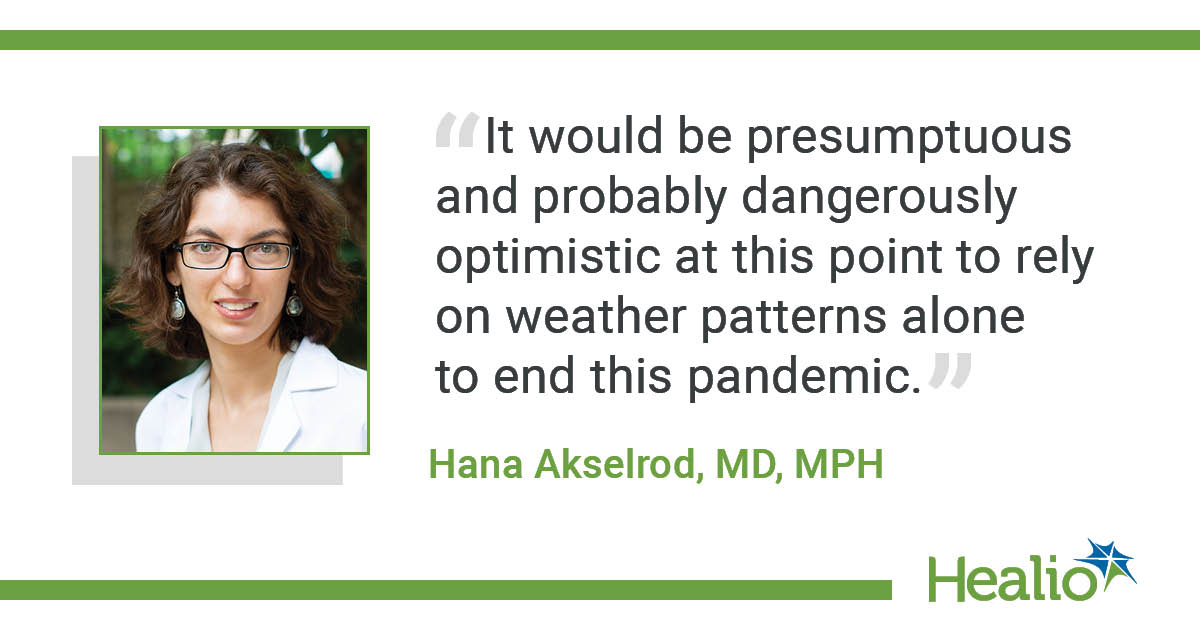Seasonality of COVID-19 Remains Uncertain

President Donald J. Trump’s tweet on Feb. 7 suggesting that “as the weather starts to warm & [COVID-19] hopefully becomes weaker, and then gone” has prompted a debate among medical professionals about the seasonality of the disease.
“As it stands right now, the transmission rate of COVID-19 is really a function of the virus itself rather than a particular season,” Mark Cameron, PhD, an associate professor in the department of population and quantitative health sciences at Case Western Reserve University, told Healio Primary Care. “Since pandemic-prone coronaviruses have not been connected to seasonality, it won’t go away simply because of warmer weather.”

Seasonal variability is one of many factors that play a role in influenza’s transmission, Nicholas B. DeFelice, PhD, assistant professor of environmental medicine and public health at Mount Sinai Health System, said in an interview.
“The fact that large populations have no herd immunity to COVID-19 suggests that changes in the atmospheric conditions may not influence disease transmission,” he said. “The transmission potential of influenza estimated from city-level incidence transmission has previously been positively correlated with population size and spatiotemporal organization in population density. This suggests that urban centers incubate critical chains of transmission outside of peak climatic conditions.”

Hana Akselrod, MD, MPH, assistant professor of medicine in the division of infectious diseases at the George Washington University School of Medicine and Health Sciences, explained that basing COVID-19’s rapid infection rate exclusively on the premise that seasonal influenza spreads faster in winter weather is likely wrong.
“The COVID-19 virus and the influenza virus come from two different families,” Akselrod said in an interview. “In addition, COVID-19 is showing up in all different types of climates and spreading exponentially through a population that doesn’t have any prior immunity to it. Therefore, it would be presumptuous and probably dangerously optimistic at this point to rely on weather patterns alone to end this pandemic.”
Others who have researched the link between weather and viral diseases have come to different conclusions, however.
Mohammad M. Sajadi, MD, an associate professor at the Institute of Virology at the University of Maryland, and colleagues wrote that temperature and humidity are “known factors” in the survival of SARS and MERS — both caused by coronaviruses, like COVID-19 — and influenza. They also reported that cities that are affected by COVID-19 are similar in average temperature (5C to 11C) and relative humidity (47% to 79%), and that colder areas in more northern latitudes are “relatively free” of COVID-19.
“All of the above points to a potential direct relation between temperature and SARS-CoV-2 environmental survival and spreading,” Sajadi and colleagues wrote.
In a press release, Michael F. Holick, MD, PhD, professor of medicine at the Boston University School of Medicine, said there were parallels between winter-associated vitamin D deficiency, which weakens immune systems, and the increased risk for other viral diseases. However, he stopped short of saying there was a link between the two.
“There is evidence that adequate levels of vitamin D during the winter can result in a reduction in the incidence of influenza A and in other viral illnesses of the respiratory tract,” he said. “Given the newness of COVID-19, no research has studied how vitamin D levels might be associated with the incidence or severity of a coronavirus infection.”
Akselrod noted the scientific community’s understanding COVID-19 is fluid.
“We shouldn’t make assumptions about this new virus,” Akselrod said. “We should base our decisions on the evidence from countries that appear to be a few weeks ahead of us in the spread of this disease.”

Cameron said there are more immediate ways to curb COVID-19’s spread rather than wait for spring and summer, which start on March 19 and June 20, respectively.
“Our best chance at controlling the COVID-19 infection rate between community members is to hold the frontline in this massive and ongoing public health response,” Cameron said. “We should keep getting information from WHO or the CDC and keep talking to people about what they can do to protect themselves and what they can do if they do feel sick. Those are the best ways of reducing and, hopefully, eliminating COVID-19 rather than waiting for better weather.” – by Janel Miller
References:
Kounang N. President Trump tweeted the coronavirus could weaken as weather warms. Scientists say it’s too early to know. CNN. Feb. 7, 2020. https://www.cnn.com/2020/02/07/health/trump-coronavirus-weaker-warm-weather/index.html. Accessed March 12, 2020.
Sajadi M, et al. Temperature and latitude analysis to predict potential spread and seasonality for COVID-19. https://papers.ssrn.com/sol3/papers.cfm?abstract_id=3550308. Accessed March 14, 2020.
Disclosures: Akselrod, Cameron and Sajadi report no relevant financial disclosures. Healio Primary Care could not confirm relevant financial disclosures of DeFelice and Holick at the time of publication.









